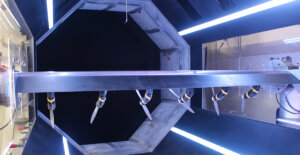
Oblique shock wave impacting on a turbulent boundary layer over a flexible panel, showing the streamwise velocity (vertical slice), the wall shear stress (blue to red on the wall), and the deflection of the surface. Background: shock-induced mixing (blue to red) shadowed by the flow speed marking the shock as the sharp gradient. IMAGE/IVAN BERMEJO-MORENO.
USC Viterbi School of Engineering Assistant Professor of Aerospace and Mechanical Engineering Ivan Bermejo-Moreno was awarded 2.1 million node hours on the Theta supercomputer at Argonne National Laboratory, as part of the U.S. Department of Energy’s Innovative and Novel Computational Impact on Theory and Experiment (INCITE) program. In partnership with the project’s principal investigator, Johan Larsson, associate professor of mechanical engineering at the University of Maryland, Bermejo-Moreno will investigate how supersonic wall-bounded turbulent flows are affected by different thermal wall boundary conditions and how they interact with flexible walls.
In the project, titled “High-Speed Turbulence with Shocks over Non-Adiabatic and Flexible Walls,” the researchers will create a database pooling data from simulations at different Mach numbers, Reynolds numbers and imposed wall temperatures. With this data, a predictive model that remains accurate across all flow conditions will be developed, improving upon existing theories, which fail at high Mach numbers for strongly cooled walls.
In the last several years, together with Jonathan Hoy, an AME Ph.D. student, Bermejo-Moreno has developed an in-house, high-fidelity simulation software to study the complex physical interactions at play when shockwaves impact upon the thin layers of turbulent flow that develop along flexible, solid walls. Relevant to vehicles flying at high-speed, these interactions often create more stress in the vehicle’s structure and decrease the efficiency of supersonic propulsion systems (such as scramjet engines). The INCITE-supported research will focus on the interaction between supersonic boundary layers and shockwaves in the presence of both rigid and flexible walls. From here, the data compiled will inform and help assess the validity of modeling techniques for near-wall turbulence in the context of large-eddy simulations.
Previously, few studies have looked at lighter, flexible structures, instead assuming that the solid walls of vehicles flying at supersonic and hypersonic speeds would be rigid.
Said Bermejo-Moreno: “The high-fidelity simulation frameworks we are developing will help in the design of future high-speed flying vehicles and their propulsion systems by complementing ground and flight test experiments at a reduced cost.”
The U.S. Department of Energy’s (DOE) Innovative and Novel Computational Impact on Theory and Experiment (INCITE) program awarded up to 60% of the allocable time on DOE’s leadership-class supercomputers: Summit, the OLCF’s 200-petaflop IBM AC922 machine, and Theta, the ALCF’s 12-petaflop Cray XC40 system to 47 projects. Bermejo-Moreno and Larsson will have access to 2,140,625 node-hours on the Cray XC40 system—Theta.
Published on December 11th, 2019
Last updated on December 11th, 2019











